|
|
Joined: Mar 2010
Posts: 623
Major Contributor
|

Major Contributor
Joined: Mar 2010
Posts: 623 |
No, I know that he can make a 2bbl plate for me, but I'm thinking if I cut the 4 barrel plate into a big square and use a 2-to-4bbl adapter then it will lift the carb enough so that the throttle linkage won't hit the manifold.
Otherwise, I'd just have to get a 2bbl plate and then just buy an spacer so that the throttle linkage wouldn't hit. This choice would be more expensive.
69 Buick Special Deluxe. Intercooled Turbo Chevy 250 @ 15psi on a stock long block. It's kinda fast.
|
|
|
|
|
Joined: Jul 2000
Posts: 4,585 Likes: 19
1000 Post Club
|

1000 Post Club
Joined: Jul 2000
Posts: 4,585 Likes: 19 |
A plate can be as thick as you need it.I have done 1&2in spacers I even did a 3inch once.But the thicker the peice is the more time it takes to make it.The more spacers you stack together the more likely you are to have a blow between the gaskets under pressure.??
Larry/Twisted6 [oooooo]  Adding CFM adds boost   God doesn't like ugly.
|
|
|
|
|
Joined: Mar 2010
Posts: 623
Major Contributor
|

Major Contributor
Joined: Mar 2010
Posts: 623 |
So if I were to get a junkyard 250 and I wanted to rebuild it so it was like new, what would I need? Something like... - Main bearings- Rod bearings- Cam bearings (maybe?) -New gaskets (Head, valve cover, manifold, oil pan, side covers?, rear main seal?) -Reuse the crank, rods, and pistons? -ARP hardware? main studs rod bolts (would I need anything besides mains and rods?) I know that's a very short list and I'm probably forgetting very obvious stuff but does that sound about right? The deal is I have all the turbo parts ready to go but I don't want to put them on my original engine so i'm getting a junkyard 250 and putting it on there. I just want to know the engine I put the turbo stuff on is going to run correctly and not leak stuff. I know I've said this before but I want to reiterate for new readers. Lastly, I know I've asked this before but where would the stock internals start failing? I would probably be pushing limits @ 10psi on stock internals and ARP hardware right? Is the ARP hardware one-time-use or should I go ahead and buy forged rods and/or forged pistons if I can scrounge up the money?
Last edited by snowman4839; 08/24/11 10:45 PM.
69 Buick Special Deluxe. Intercooled Turbo Chevy 250 @ 15psi on a stock long block. It's kinda fast.
|
|
|
|
|
Joined: Sep 2004
Posts: 5,839 Likes: 1
1000 Post Club
|
OP

1000 Post Club
Joined: Sep 2004
Posts: 5,839 Likes: 1 |
The rods ( stock ) are already forged. Get your stock rods magnafluxed, side grinded/polished & then shot peened. Get ARP bolts installed & resize the rods . Reuse crank, get it turned it needed. I would use King bearings http://www.kingbearings.com/ for rods & mains. Sealed power is fine on cam bearings. Use a complete Felpro gasket kit. Use the Felpro head gasket 1025. Stock cast piston will not tolerate much detonation @ all,that will fail first when detonated. All other parts should be able to take 10 PSI easy even your stock cast pistons can, JUST DON'T DETONATE! ARP rod bolts could be used more than once. Same for mains studs. For a more performance engine,I would buy new rod bolts everytime. Might be a good time to get some ARP head studs. Lets see some pics of your parts, all this talk w/no pics, come-on.  MBHD
12 port SDS EFI 
|
|
|
|
|
Joined: Mar 2010
Posts: 623
Major Contributor
|

Major Contributor
Joined: Mar 2010
Posts: 623 |
Wow I'm really sorry. I was under the impression I already shared pics... silly me :-P How about these apples? TURBO!!! 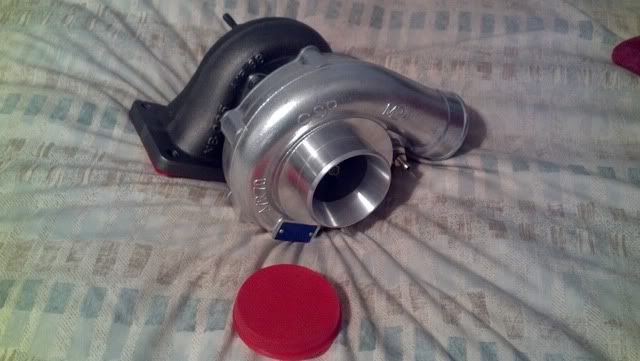 38mm wastegate 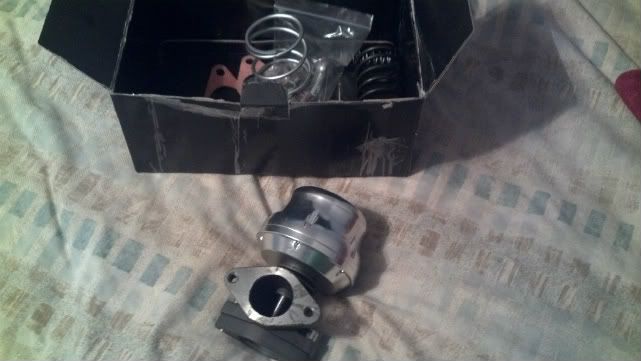 B.O.V. 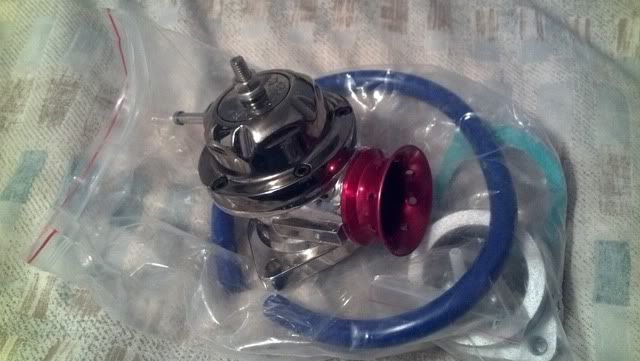 AEM wideband 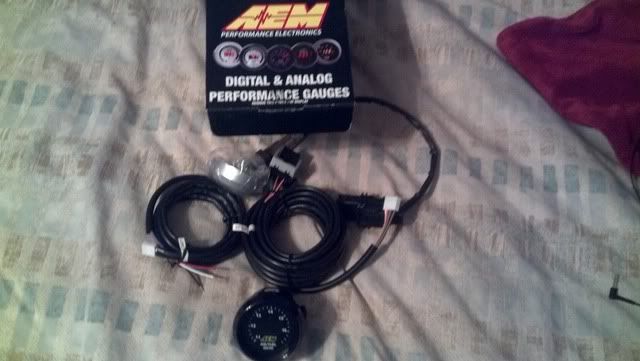 Sunpro Vacuum/Boost Gauge 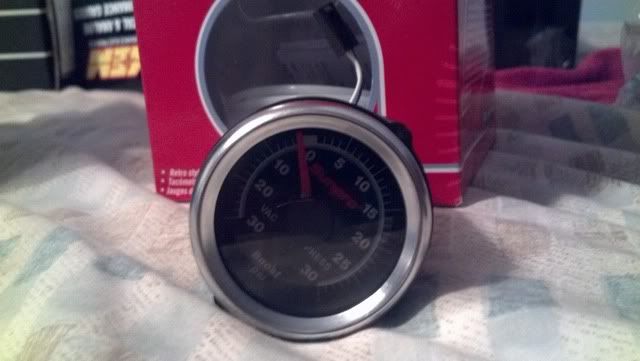 Spectre Plenum 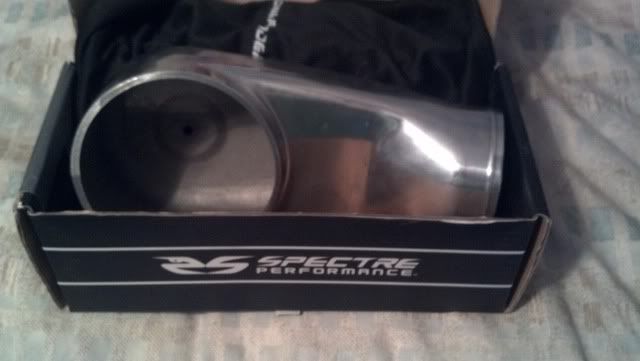 4" to 2.5" Coupler  500CFM 2bbl Holley that I just rebuilt 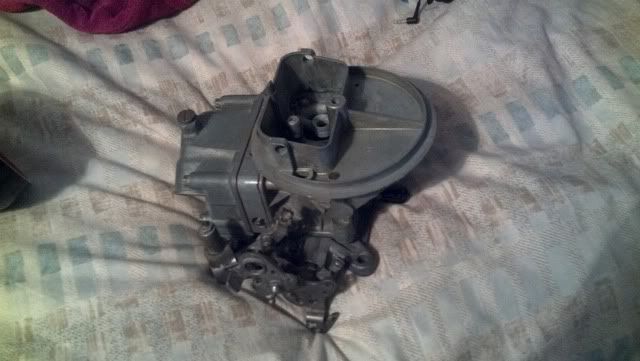 4 to 2 barrel adapter  Fuel Pump (Which I need instructions on how to modify) 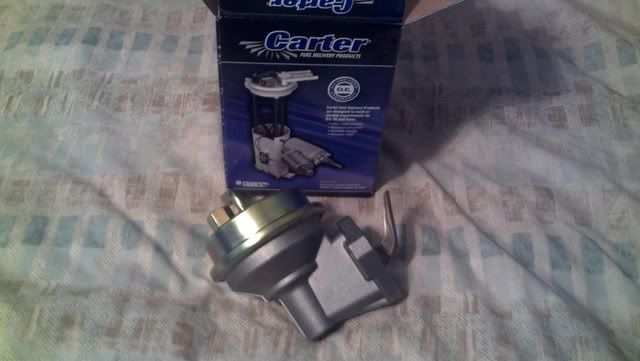 Weldable T4 flange 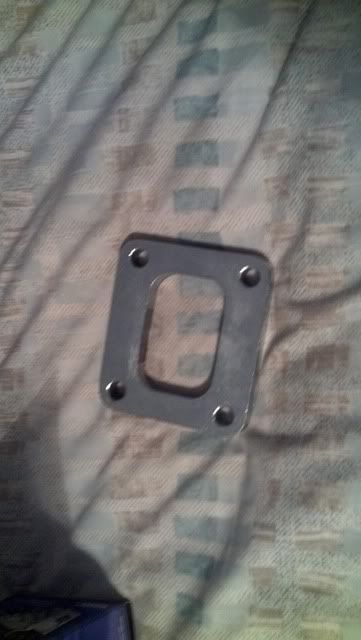 I also bought some 2.5" stainless pipe and some 2.5" stainless bends that I don't have pictured. I also have a 3 stud 2.5" 292 exhaust manifold.
69 Buick Special Deluxe. Intercooled Turbo Chevy 250 @ 15psi on a stock long block. It's kinda fast.
|
|
|
|
|
Joined: Mar 2010
Posts: 623
Major Contributor
|

Major Contributor
Joined: Mar 2010
Posts: 623 |
The rods ( stock ) are already forged. Get your stock rods magnafluxed, side grinded/polished & then shot peened. Get them resized & ARP bolts installed. Reuse crank, get it turned it needed. I would use King bearings http://www.kingbearings.com/ for rods & mains. Sealed power is fine on cam bearings. Use a complete Felpro gasket kit. Use the Felpro head gasket 1025. Stock cast piston will not tolerate much detonation @ all,that will fail first when detonated. All other parts should be able to take 10 PSI easy even your stock cast pistons can, JUST DON'T DETONATE! ARP rod bolts could be used more than once. Same for mains studs. For a more performance engine,I would buy new rod bolts everytime. Might be a good time to get some ARP head studs. Lets see some pics of your parts, all this talk w/no pics, come-on.  MBHD Are they really?? Then why would anyone upgrade to different rods if the stock is already forged? Different shapes that are stronger?? I'm hoping to do this with as little machine work as possible considering I need this done in a timely and cost-effective manor... How much and how long would the stock rods getting machined take? Why would I need ARP bolts "installed". Wouldn't I do the "installing" during assembly? Again how much would turning the crank cost? That was something I was thinking about because I read in santucci's book that there are several different types of rod and main bearings but king bearings only had a small hole for the oil whereas the sealed power had a small hole and a groove for the oil to travel through on the lower half of the bearing. From a novice's standpoint, it seems like it would be better for the oil to contact in the hole as well as in the groove making Sealed Power the better product (more oil contact = better lubrication?) I've heard that it isn't uncommon to forgo replacing cam bearings at all because they also require a special tool. Is that something I could do here or is it pretty much a necessity? Is there a way to protect against detonation (besides keeping ignition at TDC? lol) Well the only reason I asked is because they're like $60 a set and if I ever change rods or whatever, it seems like a waste to rebuy the bolts. I was thinking about the ARP head studs but wouldn't that interfere with a lump kit when I install it in the future?
69 Buick Special Deluxe. Intercooled Turbo Chevy 250 @ 15psi on a stock long block. It's kinda fast.
|
|
|
|
|
Joined: Sep 2004
Posts: 5,839 Likes: 1
1000 Post Club
|
OP

1000 Post Club
Joined: Sep 2004
Posts: 5,839 Likes: 1 |
Thanks for the pics, but I think there a bit big?
Yes, the stock rods are forged.
Aftermarket rods will be stronger than your stock rods.
Time for rod machineing? Depends on if the shop you take it to is busy. If they are not busy,you could drop them off in the morning & they could have them done @ the end of the day.
You would install new rod bolts, then have them machined & resized in that order.
I am not too current on prices for resizing rods, approx $10 a rod? At the most $100 for a set of 6? Most likely less.
If your crank does not need to be turned, just a polish would be good $30 ,turning crank & polish $100 ?
If you chemically strip the block acid dip, you would take out your cam bearings, if they look good & you get the block cleaned w/not so harsh a chemicle they can stay in block & possibly re-use,depends on condition. Need a special tool that can cost $150-$300 to install cam bearings. Again, not too up on pricing. Just thinking off the top of my head.
You can use any of those bearings, I just recommended the KING bearings. I used TRW/Sealed Power w/no problems.
I had told you a good way to prevent detonation is to get one of these: http://www.alkycontrol.com/& one of these: http://www.jandssafeguard.com/
As far as a lump port head & head studs, you just would not use 3 of the long head studs when you switch to the lump ports.
MBHD
12 port SDS EFI 
|
|
|
|
|
Joined: Sep 2004
Posts: 5,839 Likes: 1
1000 Post Club
|
OP

1000 Post Club
Joined: Sep 2004
Posts: 5,839 Likes: 1 |
12 port SDS EFI 
|
|
|
|
|
Joined: Sep 2004
Posts: 5,839 Likes: 1
1000 Post Club
|
OP

1000 Post Club
Joined: Sep 2004
Posts: 5,839 Likes: 1 |
More pics of turbo please.
Try & not have them so-big, if possible.
MBHD
12 port SDS EFI 
|
|
|
|
|
Joined: Apr 2004
Posts: 3,556 Likes: 35
1000 Post Club
|

1000 Post Club
Joined: Apr 2004
Posts: 3,556 Likes: 35 |
Those big pic's are a killer for me. I won't even look at this thread anymore. They take forever to load with a slow DSL .
Inliner Member 1716 65 Chevelle Wagon and 41 Hudson Pickup Information and parts www.12bolt.com
|
|
|
|
|
Joined: Sep 2004
Posts: 5,839 Likes: 1
1000 Post Club
|
OP

1000 Post Club
Joined: Sep 2004
Posts: 5,839 Likes: 1 |
snowman4839 did you install your wideband reader yet?
It would be interesting to all of us here as to what your A/F ratios are right now.
How is your car running now & what intake & carb are you using right now?
MBHD
12 port SDS EFI 
|
|
|
|
|
Joined: Mar 2010
Posts: 623
Major Contributor
|

Major Contributor
Joined: Mar 2010
Posts: 623 |
Sorry guys, I tried to resize it but it didn't do anything. I guess tlowe will have to wait till it goes to the next page so that it won't load these pictures.
I didn't install the wideband reader because it only came with one bung and I don't intend on wasting it.
I know I'm running extremely rich right now because I can leave my car running in one spot for a minute or two and it'll make a black spot on the driveway from the exhaust.
My car is running pretty well right now, still using the Holley 390 4bbl with the offy. I'm going to put all the turbo stuff like the holley 500cfm 2bbl and the wideband and all on the turbo engine whenever it is that I get it...
69 Buick Special Deluxe. Intercooled Turbo Chevy 250 @ 15psi on a stock long block. It's kinda fast.
|
|
|
|
|
Joined: Sep 2004
Posts: 5,839 Likes: 1
1000 Post Club
|
OP

1000 Post Club
Joined: Sep 2004
Posts: 5,839 Likes: 1 |
12 port SDS EFI 
|
|
|
|
|
Joined: Sep 2004
Posts: 5,839 Likes: 1
1000 Post Club
|
OP

1000 Post Club
Joined: Sep 2004
Posts: 5,839 Likes: 1 |
12 port SDS EFI 
|
|
|
|
|
Joined: Mar 2010
Posts: 623
Major Contributor
|

Major Contributor
Joined: Mar 2010
Posts: 623 |
Oh ha ha ha. I didn't even think about buying another bung for it.
Thanks for that mod. Makes sense how it works now.
WHY IS ARP HARDWARE SO EXPENSIVE?? I mean I had the rebuild priced out on summit (Main bearings, cam bearings, rod bearings, gasket kit, and ARP hardware) and the ARP hardware alone was like $200? Is it really necessary to get ARP studs? What benefit does it provide?
And if I have a running motor, would I need to replace the piston rings? I doesn't seem like I would need to unless they're damaged right?
And I've been reading up on wrist pins and it got me wondering. When I'm disassembling the engine, would I need to even separate the pistons from the rods since I'm using the stock rods and pistons? Are wrist pins something you'd need to replace? And the 250 uses pressed wrist pins right? Not "floater" pins with retainer rings? And if I ever decided to upgrade to forged pistons, would I need to take the connecting rod/piston somewhere to get the pin out or could I do it myself? And to get it in, don't you just heat the connecting rod and slide it in and oil it?
And what do you guys suggest in terms of cams/valvetrain? Do I need to get a whole new valvetrain (cam, lifters, pushrods, rockers, rocker studs, valves)? My plan was to get a whole new valvetrain with CompCams recommendation for a turbo cam. and it seems like I remember needing a new valve cover for non-stock rockers?
69 Buick Special Deluxe. Intercooled Turbo Chevy 250 @ 15psi on a stock long block. It's kinda fast.
|
|
|
|
|
Joined: Jun 2011
Posts: 21
Active BB Member
|

Active BB Member
Joined: Jun 2011
Posts: 21 |
I got all my ARP hardware here. They were reasonably priced. http://www.cnc-motorsports.com/
|
|
|
|
|
Joined: Sep 2004
Posts: 5,839 Likes: 1
1000 Post Club
|
OP

1000 Post Club
Joined: Sep 2004
Posts: 5,839 Likes: 1 |
WHY IS ARP HARDWARE SO EXPENSIVE?? I mean I had the rebuild priced out on summit (Main bearings, cam bearings, rod bearings, gasket kit, and ARP hardware) and the ARP hardware alone was like $200? Is it really necessary to get ARP studs? What benefit does it provide?
ARP is the best, probably part of the reason of it's price.
Are you talking about the main caps & installing studs there?
If so, it's not manditory to use studs. High HP high RPM? Use main studs & dowell the main caps.
Benefit, there hardware usually does not break.
And if I have a running motor, would I need to replace the piston rings? I doesn't seem like I would need to unless they're damaged right?
Rings wear out, they dont seal as good when they were new.
You can perform a cyl leakage test to see how well the "running motor" is sealing up. It's always a good idea @ least to hone the bores & install new rings, you don't need to do it if everything is up to snuff.
But, I would install a new set, & you need to know how they are installed, they have markings on them & instructions when you buy new.[/color]
And I've been reading up on wrist pins and it got me wondering. When I'm disassembling the engine, would I need to even separate the pistons from the rods since I'm using the stock rods and pistons? Are wrist pins something you'd need to replace? And the 250 uses pressed wrist pins right? Not "floater" pins with retainer rings? And if I ever decided to upgrade to forged pistons, would I need to take the connecting rod/piston somewhere to get the pin out or could I do it myself? And to get it in, don't you just heat the connecting rod and slide it in and oil it?
If you are just reusing your old piston & rods & slapping it back together,then , no you do not need to remove your piston pins.
You would need a fixture & a press to get them out(most likely) people do not have a fixture to hold the pistons correctly, & if you do not, you will dammage/break a piston. (Shop recommended)
There are special little ovens to put a rod into to super heat the small end (I mean glowing red) & you only have a few seconds to slide the pin in, if not slid into place correctly & in time, you will need a press & fixture to properly press the pin in all the way (it's sort of a pain when you dont slide it in on time)
If you are installing new rods bolts, you would need to remove the pistons from the rods & get the big end of the rods resized.
And what do you guys suggest in terms of cams/valvetrain? Do I need to get a whole new valvetrain (cam, lifters, pushrods, rockers, rocker studs, valves)? My plan was to get a whole new valvetrain with CompCams recommendation for a turbo cam. and it seems like I remember needing a new valve cover for non-stock rockers?
If you get a new cam, you need new lifters.If you see worn/bent push rods, replace them.
Personaly, I like to install new valve train so there is less to worry about.
If you use/buy aluminum roller rocker arms,you need a larger internal valve cover.
I believe the Clifford valve cover is supposed to clear for such an issue.
I use an Offy valve cover w/gold Crane rocker arms, I have to clearance the valve cover on both ends & round off the # 1 & 12 rocker arms. I also stacked some valve cover gaskets.
Companys always suggest, to use match sets of gears drives for the camshaft.
Meaning, if you buy a new camshaft gear you would need to buy a new crank gear drive also.
Guy are making valve cover spacers now to give a bit more clearance (raise the valve cover higher) better idea than stacking gaskets B.T.W.Example: http://www.t6racing.org/id4.htmlMBHD
12 port SDS EFI 
|
|
|
|
|
Joined: Feb 2010
Posts: 136
Contributor
|

Contributor
Joined: Feb 2010
Posts: 136 |
I was reading your build and noticed you were considering a cam. I am running this one and it seems really good. Plus, Steve at Lunati is straight up.
Custom Lunati Turbo Spec cam (212/202,270/262 adv dur, 114LSA, .465/.458 lift)
Good Luck and look forward to updates
|
|
|
|
|
Joined: Mar 2010
Posts: 623
Major Contributor
|

Major Contributor
Joined: Mar 2010
Posts: 623 |
MBHD: Why wouldn't I "necessarily" need a new valvetrain? Wouldn't it make sense to maximize the potential of a blow-through setup with a turbo cam? How much power would I lose not using a turbo cam? So if a new valvetrain isn't "necessary", doesn't that mean the redline will be the same? Which means it won't be a high rpm motor? Which means I don't need ARP hardware? I said ARP was expensive because head studs are like $100 for a set, main studs are like $50 and rod bolts are like $50. Could I just reuse the original hardware then? Here's what I'm wondering. What would happen if I just rebuild the engine with new gaskets and bearings (but reuse the old piston rings if they keep good compression), put the old valvetrain back in, and just put all the turbo stuff on the basically stock engine and run it at like 10psi? What would that do? I mean the stock compression is already pretty good for a turbo engine, IIRC a turbo cam is just a slightly different stock cam with higher lift, and it already has a pretty sturdy rotating assembly and good oiling system. What type of power would that make? or would it even be worth putting together? What parts would make the most difference in performance and/or longevity? And lastly, how weak would those pistons be to 10psi? And how are you supposed to find the right timing if any amount of pinging would destroy the pistons? I always find where it starts pining and back it off just a little to where it stops. It seems like I'd just advance it a fair amount, make sure it doesn't run lean and I'd have a pretty strong motor but I'm still all in theory, you guys have the real-world experience... Boucher: Thanks, but now I'm rethinking even getting a cam after what MBHD said. Last thing, I got an oiling kit a week or so ago. Cam with a feed and return line. I noticed that there are two ways you can put the feed line in. Screw it in directly to the threads in the housing, or attach a feed plate with a very small feed orifice. Which should I use? Directly in 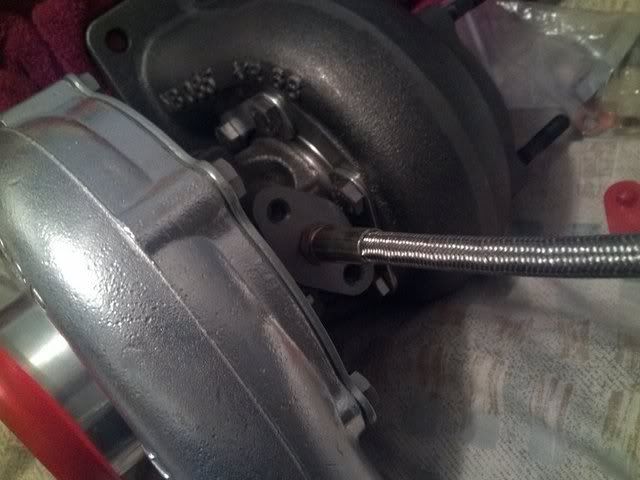 The plate 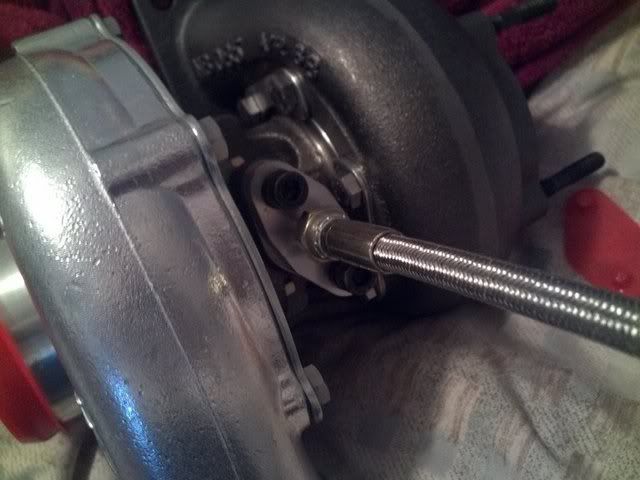 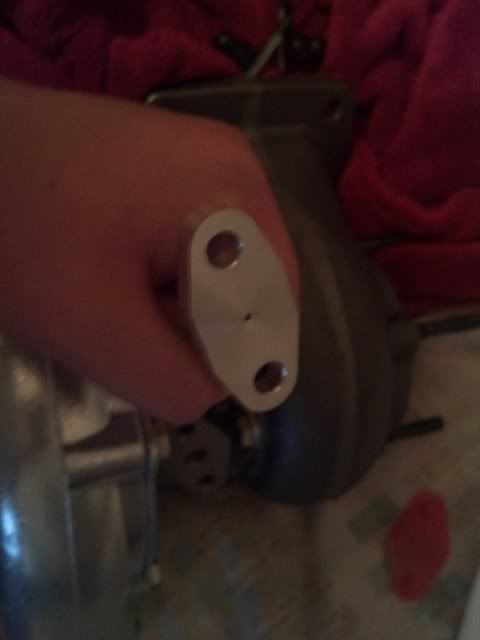 And with the return line, how do you connect it to the oil pan? Is it supposed to be above or below the oil line? And do you just tap a hole in the pan or what? EDIT: also if I wanted to just make a short adapter from the 3 bolt to the t4 flange and make it fit, could I just mount the wastegate on the bottom of the exhaust manifold like on the SPA manifold but just do it on the flat part on the bottom between cylinders the 2/3 and 4/5 exhaust ports? And just drill and tap 2 screw holes and hole saw the 38mm hole for the actual exhaust to flow out of? Then just bolt the wastegate right up to it with a gasket and a generous amount of high-temp gasket sealer?
Last edited by snowman4839; 09/19/11 01:06 AM.
69 Buick Special Deluxe. Intercooled Turbo Chevy 250 @ 15psi on a stock long block. It's kinda fast.
|
|
|
|
|
Joined: Sep 2008
Posts: 3,669 Likes: 42
1000 Post Club
|

1000 Post Club
Joined: Sep 2008
Posts: 3,669 Likes: 42 |
Snowman, you have already spent some good money buying nice pieces, it doesn't make since to start cutting corners before your done, especially on some of the more critical areas. You should at least put a fresh bore on your block with new rings. Trying to re-use the old rings just wouldn't even be an acceptable alternative. Is the ARP stuff a requirement....no, more a luxury and added insurance considering your build potential. That would be an area to shave a few dollars off of the budget if you had to. But don't even consider re-using the stock rings at all. Its likely you will get them mixed up and out of order and just create another issue all together, like them not re-seating. If you had just rebuilt the engine and they had just a few miles on them, then sure. Does your block have a ridge at the top of the cylinders? Chances are you have already broken several rings when you knocked the pistons out of the cylinders to start with. Just keep thinking "smart" and don't try to rush it just because you see the light at the end of the tunnel.
Class III CNC Machinist/Programmer
|
|
|
|
|
Joined: Sep 2004
Posts: 5,839 Likes: 1
1000 Post Club
|
OP

1000 Post Club
Joined: Sep 2004
Posts: 5,839 Likes: 1 |
Snowman,,, You seem to be switching back & forth, I do not know if you are talking about just slapping an engine together (re-ring & re-bearing an engine) slap a turbo on & see what it can do or semi building a purpose built new turbo engine? New forged pistons, reusing cast used pistons??? I would definately run a new turbo designed camshaft. Stock cam is anemic.Since this would be a daily driver I would not make it a high RPM high HP engine for day to day driving. I'm talking 5000-5500 tops RPM. You can just run the stock head bolts & a good head gasket for low boost. ARP head studs will clamp down better than stock head bolts & less likely to push out a head gasket,, but if you detonate anything can happen, even w/head studs, burn a piston, blow a head gasket, break a conecting rod,put a hole in the block etc. Minimun needed is @ least ARP rod bolts, resize the rods, side grind/polish connecting rods, magnafluxed,& shot peened. Not in that order. You could re-ring & bearing the engine,but I still say resize rods, new ARP rod bolts polish & shot peen rods. Cast pistons could take 10 psi of boost pressure AS LONG AS THE ENGINE DOES NOT DETONATE!I have said it before, you cannot always hear detonation. That is why I recommend one of these, http://www.jandssafeguard.com/you install a knock sensor & it will retard the timing on all the cylinders or retard the timing for the cyl that is knocking.(selectable) So just a recount, I do not know your intensions,new pistons, reuse all old parts or??? If you just want to get a cheap$$ turbo engine going (different longblock I assume?) Minimum things to do (on the cheap $$$),,,, Re-ring & bearings. ARP rod bolts side grind/polish & shot peen rods,magnafluxed.
New turbo camshaft,new push rods, new lifters, new cam gear, new crank gear, larger 1.94" intake valve 160"exhaust valves installed,mild porting & a great valve job, new Felpro headgasket P.N.1025 IIRC?
Profile/port/grind intake port boss, make them narrow with out breaking through where the head bolts go through, (winged shape,like an airfoil) No lumps needed. The turbo is going to force your air/fuel mixture into your engine.
Get a good methanol injection system. http://www.alkycontrol.com/
I can see a low buck $$ engine like that making 300-400+ HP to the wheels, if tuned correctly.You can get away with more pinging w/forged pistons as compared to cast pistons,, but forged pistons can easily be destroyed also if it's pinging @ high boost & you don't get out of the throttle in time. As far as your turbo feed set-up, usually a turbo w/journal plain bearings (not ball bearings) you do not need a restricter hole. Some ball bearing turbos like Turbonetics do not require a fixed small orifice, but Douglas said on his Y2K Turbonetics turbo he needed one on his race car because the engine was injecting oil, he also was running a dry sump system that pumped high volumes of oil also. So not so sure about that one?? Other BB turbos require a fixed orifice. I think it depends also on your oil system, stock or high volume high pressure oil system. You could ask the Co. you bought the turbo from what they recommend.Now for the turbo oil return/drain line, you need the return fitting in the oil pan above the level in the pan. you want the return line angled down (from the turbo down to the pan) w/no loops or kinks. You want it to be a good sized tube or hose for the return.Examples: http://www.google.com/imgres?imgurl=http...9QEwAw&dur=2346http://www.google.com/imgres?q=turbo+oil...38&tx=110&ty=62http://www.google.com/imgres?q=turbo+oil...iw=1201&bih=738Angle pipe welded: http://www.google.com/imgres?q=turbo+oil...iw=1201&bih=738Hope this helps  MBHD
12 port SDS EFI 
|
|
|
|
|
Joined: Mar 2010
Posts: 623
Major Contributor
|

Major Contributor
Joined: Mar 2010
Posts: 623 |
Well I'm talking about doing whatever would be the most cost effective. I was asking about just using stock pistons because forged pistons are $500 and that would save me a lot of money if forged pistons were only necessary for like 600hp+. I'm just talking about taking a different engine than the one in my special, taking it apart, rebuilding it with new bearings and gaskets (and I guess pistons rings now), then using whatever new parts that would be cost effective for what I'm looking for (12ish second car with 300-400hp). So so far I need, new turbo cam and valvetrain, bearings, gaskets, machine work on the rods, new rings, resize valves. And are lump ports necessary? BTW, how much is a valve resizing and whatever other machine work I'd need?
What do you consider the head bolts to be good for? What do you mean by "low boost"? 15psi max? 25psi max? And can I use those head bolts with a lump kit or does the kit come with its own special head bolts for under the lumps? Or are lumps going to help hardly at all since it's turbo'd? I saw that lumps were $70 plus shipping on turbo6's site i think? Would it be worth it?
Last thing is that J&S system is pretty pricy for $450. Any cheaper alternatives? It seems like I would either get forged pistons to stand up to a little bit of pinging or get the J&S system to keep my stock pistons from exploding. Because I can't do both because that's $1000 in just those parts. ON TOP OF THAT... the alky injection is like $400+ from what I've seen. You consider this a low $$ engine?? I didn't expect to need ALKY til I got up to like 20PSI+
69 Buick Special Deluxe. Intercooled Turbo Chevy 250 @ 15psi on a stock long block. It's kinda fast.
|
|
|
|
|
Joined: Sep 2004
Posts: 5,839 Likes: 1
1000 Post Club
|
OP

1000 Post Club
Joined: Sep 2004
Posts: 5,839 Likes: 1 |
Snowman, If you are going to stay on a low dollar theme. Lumps are not necessary @ this point.Will they help? sure they will. The turbo is going to force the air & fuel into your engine & having a better short turn radius is not as critical as when the engine is naturally aspirated. But you need to open up the intake port windows to allow more air/fuel to get into your engine. Meaning , you need to profile/make smaller the intake bosses. Do some bowl work & the short turn radius'. Port the exhaust port all the way through & a good valve job. Installing oversized valves,rough estimate approx $10-15 each so that's $120-$180 bowl work/porting can vary a lot. $200 to $400 & up It's not cheap, & you should not skimp there if you want to make some good power. Valve job, guides installed $125-$200 surface head. $40-60. It all adds up to a lot, but this is where all your power is going to be coming from, a great flowing cyl head. If you can do some of the porting yourself & you can save some $, but you can cut/grind into water jackets if you go too far.So you would need to be carefull. You can look @ this site to give you some ideas of costs. http://12bolt.com/250292_inline_products/cylinder_heads_and_rocker_arms. IMO, Those prices are lower than what most shops will charge you. It's just the norm for when you want to go fast/faster, speed costs money.  W/a good head gasket & stock head bolts I can see you running 15 lbs of boost w/no problems. What I think of low boost is about 10 psi or less. The lump port kit should come with special head bolts. You could buy the lumps & it will improve the power output, just not as much difference as if you were just running a naturally aspirated engine, (again, the turbocharger is forcing the air/fuel mixture into the engine,so it is not a critical.) You need to make sure your intake port window are larger than stock in order to flow more along w/the larger 1.94" intake valves. I would only profile your cyl intake boss & that alone will open up your intake port window & still have some high intake port velocity. As far as the J&S goes, yes it's pricey, but it will save your engine. Alternative, you could just buy an MSD boost timing master box. You would set how much timing you want to take away per psi of boost pressure. It works, just not as safe. It cannot detect knock.It cannot sense if your engine is detonating as the J&S does when using a knock sensor. If you keep your boost low, approx 10 psi & conservative on the timing, you would not need methanol injection. But you need an intercooler for sure. I know all this sounds expensive, but you should see how much time & money guys put into a high power turbo set-ups,shocking  It's all the initial parts that cost money. You could just throw your turbo onto your engine & that would be a low buck turbo install. That is what I call a low dollar turbo install.Put a turbo onto your engine that is in your car, add an intercooler & all the little odds & ends. That's a low dollar turbo install. It will not make make that much power either. Plan & simple speed cost money. You want to run 12's, You are making the engine swap choices, cam swap, etc etc etc. It all depends on how fast do you want to go? Speed cost money & a 6 cyl turbocharged Chevy build is not cheap. Guys are putting junkyard Chevy LS engines into there old cars, run the stock exhaust manifolds flipped around backwards & add a turbo , intercooler etc etc etc, those builds are cheap & can make a-lot of power, they are still not doing the swaps for just $1000 dollars, you add up all the parts & guess what it still adds up to more money than you would want to spend. So the choice is yours on what you want to do. If you want a low dollar turbo charged inline 6. Re-ring & bearings, ARP rod bolts, resize the rods, install a turbo camshaft & lifters.Good headgasket.That is a low dollar turbo set-up. It still costs money. MBHD
12 port SDS EFI 
|
|
|
|
|
Joined: Mar 2010
Posts: 623
Major Contributor
|

Major Contributor
Joined: Mar 2010
Posts: 623 |
I need to make a list of things I'll need to take to an engine shop to get estimates so correct me if this is wrong. This is a complete list of everything I might need so tell me what's necessary/recommended.
Rods: magnaflux, shot peen, resize (do you resize the bottom or the top where the wrist pin goes through or both?)
Head: Magnaflux, resize valves to 1.94" and 1.6", would I need new valve guides? Could I port/polish myself?
Block: Magnaflux, Bore .060 over, Hone?, new cam bearings. alignment hone?
Crank: Magnaflux, Turned?
that means I'd need new bearings, pistons, rings, valves, valve guides? valves seats?, and the rest of the valvetrain.
69 Buick Special Deluxe. Intercooled Turbo Chevy 250 @ 15psi on a stock long block. It's kinda fast.
|
|
|
|
|
Joined: Mar 2010
Posts: 623
Major Contributor
|

Major Contributor
Joined: Mar 2010
Posts: 623 |
69 Buick Special Deluxe. Intercooled Turbo Chevy 250 @ 15psi on a stock long block. It's kinda fast.
|
|
|
|
|
Joined: Sep 2004
Posts: 5,839 Likes: 1
1000 Post Club
|
OP

1000 Post Club
Joined: Sep 2004
Posts: 5,839 Likes: 1 |
When you are doing such a project, you really need to take off your exhaust manifold on the car & actually install your 2.5" exhaust manifold to see where everything is going to be laid out. (less cutting & re-do work IMO.)
IIRC, Tlowe said the the 2.5" manifold exhaust hole is positioned a lot more fwd as compared to the stock 250 manifold & would most likely sit directly over the crossmember/frame? Saying that (& I am only quessing you would need a really tight radiused pipe. Just quessing here because I have not seen your set-up first hand.Not sure the thickness of your square flange (3 hole) you made? but, Might I suggest using a thicker metal flange. I would suggest a thickness of .375" or 3/8? And it should be chamfered like the exhaust manifold is to kinda centers the donut gasket? I am thinking your plate is going to distort. Just a suggestion. Definately reshape the round section of tubing for the T4 flange. When you are welding pieces together, make sure there is no extra slag/weld inside the tubing that can come loose (dislodge into the turbine wheel & distroy it) & or restrict airflow. Looks like you are using a stick/arc welder? BTW, just some FYI, on another forum a guy w/a supercharged Cadi STS-V 4.4 liter (bigger than your 250) switched over to a turbo set-up, he was running a .81 A/R on the turbine housing & his turbo would not get full boost until 4000+ rpm. Guys on that forum were telling him that the turbine A/R was fine for what his combo was, I suggested to get a smaller A/R for the turbine & surprizingly  the guy took my advise against all the others advise & he was happy he did, by switching to a smaller .68 A/R turbine housing(IIRC?)the boost comes in much sooner. He also had his torque converter restalled to 3000 RPM & got reinstalled & now it stalls to 2800 RPM, it actually needs a few hundred more RPM stall to get rid of the turbolag. If he would have stayed w/the .81 A/R turbine housing the engine would have needed approx 3600- 4000 RPM stall. I advised him he would not like to wait for the boost to come in so late in the RPM & running a 4000 stall converter on the street would not be a happy thing to deal w/on a street car. He is still doing more tuning but when he dynoed it made 502 HP @ the wheels @ 13 psi of boost pressure. Just trying to reasure you about the A/R choice on your turbo, going to an A/R of .84 or bigger, you definately would not like it for a daily driver. That's all.  I would also like to add that I am not bagging on your work @ all, just want to see you succede.  BTW, is your dad helping you @ all w/this project? Did he drag race his V-8 sled,,um I mean Buick @ a track yet LOL.  MBHD
12 port SDS EFI 
|
|
|
|
|
Joined: Sep 2004
Posts: 5,839 Likes: 1
1000 Post Club
|
OP

1000 Post Club
Joined: Sep 2004
Posts: 5,839 Likes: 1 |
Rods: magnaflux, shot peen, resize (do you resize the bottom or the top where the wrist pin goes through or both?)
Head: Magnaflux, resize valves to 1.94" and 1.6", would I need new valve guides? Could I port/polish myself?
Block: Magnaflux, Bore .060 over, Hone?, new cam bearings. alignment hone?
Crank: Magnaflux, Turned?
that means I'd need new bearings, pistons, rings, valves, valve guides? valves seats?, and the rest of the valvetrain. OK, you are getting off track again... Now you are saying you are going to buy ..060" oversized pistons & bore your block????   Second: your rods need to be side grinded/polished (grind off the forging line smooth)*(FIRST)* then magnafluxed & you only re-size the big end of the con rod after you have installed the new ARP rods bolts. You will most likely need bronze walled valve guides installed. Head porting: You really need to know what you are doing when it comes to porting, & unless you can have someone show you how to do it, I would not recommend for you to take on such a labor intensive & needing great skills in order for you to do a port job, you can get into trouble very quickly & destroy a cylinder head. If you are determined to do the porting, buy yourself a good porting book or a video that will show you how to port. You would only do porting after a shop has used a cutter for the oversized valves (in your case a 1.94" & 1.60" sized holes) No valve job done,, until you are done with the porting. Crank: magnafluxed, turned down if needed, or just a quick polish job if thats all required. You might need new cam bearings & have a shop install them. Hope this helps. MBHD
12 port SDS EFI 
|
|
|
|
|
Joined: Mar 2010
Posts: 623
Major Contributor
|

Major Contributor
Joined: Mar 2010
Posts: 623 |
I wasn't trying to get off topic again... CNC-Dude said that with what I've already bought, I shouldn't cut corners now especially with block work I.E. Boring. And since I'm boring it out and I'll need new pistons anyway, how much are a set of forged pistons? Because all I saw were the ones on 12bolt from Tom and those were a bit pricey but I don't know what they should go for anyway. Also, do the pistons have to be made specifically for a 250 for whatever reason or can you just use a set of forged pistons with a bore of 3.875" (if the bore is stock)? Or do they have different wrist pin sizes? How can you tell what pistons will fit? Like can I bore it .040" over and use these pistons? (I'm going to compare them to stock reproduction pistons) It says they're for a Jeep but they have the right size bore (if I bore it .040" over, same size rings, press fit pins, their wrist pins have a size difference of .004", but the thing that might really mess it up is that their compression distance is .287" different (the jeeps pistons being shorter). Could you shave the top of the block enough to compensate? Because if you just put those in there with that much of the cylinder left uncompressed, the compression ratio would be way too low. I also found GMC pistons where the wrist pin size is correct but the compression distance is .287 too tall rather than .287 too short like on the jeep EDIT: SCRATCH ALL OF THAT ^^^^^ I've been doing a lot of looking and it looks like my best bet would be a set of 307 forged pistons right? The only difference is like .05" in the compression height. But those are still hard to find too! I'm using a fluxcore mig welder. I can't afford a new welder after all this stuff but it seems to work fine to hold pipe together. I know I probably should have waited until I got the manifold on the car to start this but I wanted a rough idea down and from the crude measurements I took, it will fit right about the frame rail and have about a 0.5"-1" of clearance. I'm going to take my manifolds on my car off for a weekend and then get the fitting all sorted out and then build the other engine with that pipe knowing that it will fit. What was that guy running in terms of compression and fuel? It would be very impressive if he was running premium with like 9:1 with no meth injection. But if it's just race fuel then it's not street practical. I think the bolt flange is 16 gauge steel. Where would you buy anything thicker? That's the thickest TSC or Lowes or Home Depot carry. The T4 flange is like 1/2" thick I think and instead of reshaping the pipe, I was going to grind away at the lower part of the flangewall until I hit the pipe so it will make a smoother transition from the pipe to the turbo. and no my dad hasn't dragged his car yet. We're still working on putting the front end together on it. We're putting in new springs, shocks, spindles, disc brakes, brake lines, master cyl and booster, proportioning valve, ball joints, idler arms, blah blah blah... on the front end so that it can handle the heavier block (350SB to 400BB) and because it needs it. But his engine and transmission (Buick 400 v8 and Turbo 400 with shift kit) are waiting to go in. I told you it made 300hp, 410ft/lbs @ the crank a while back. So... Rods: Resize with ARP bolts installed then Magnaflux Head: Magnaflux then new valve guides, basic porting job, resize valves, valve job. Crank: Polish, turn (if needed), then magnaflux Block: Cam bearings (How do I know if I need them?) and is that a no on the alignment hone? Does anyone know a Rick C. on this board? I got an email from him saying he posted on one of my threads but I couldn't find any new comments that lead me to believe it was him.
Last edited by snowman4839; 09/21/11 07:19 AM.
69 Buick Special Deluxe. Intercooled Turbo Chevy 250 @ 15psi on a stock long block. It's kinda fast.
|
|
|
|
|
Joined: Sep 2004
Posts: 5,839 Likes: 1
1000 Post Club
|
OP

1000 Post Club
Joined: Sep 2004
Posts: 5,839 Likes: 1 |
Snowman, tell this Co, what size round plate you need , they will make one & ship it to you. Here: 3/8 http://www.ebay.com/itm/3-8-375-STEEL-PL...=item4aa7f264ea.250: http://www.ebay.com/itm/1-4-250-STEEL-PL...=item4aad6a51e4You would need to buy from a metal supply CO, or Amazon.com, dont laugh, I got a piece of 6" round aluminum tubing .120 wall thickness & approx 40inches long for $23.00 shipped to my house. I thought it was a great deal. People on Ebay sells titanium, aluminum, stainless,mild steel etc, I am sure if you search you could find a chunk of mild steel or stainless for a flange you need. That's if you cannot find a local metal supply Co. I think the pistons that Tlowe sells will give you pretty high compression. A custom piston is going to run approx $100 per piston last I looked. For the pipe that attaches to the T4 flange,,,, you need to shape the pipe into the dimetions of the T4 flange. Here are pics of polished con rod, you remove the forging line on the side of the rod. http://www.google.com/search?q=pic+of+po...&rlz=1I7GPEA_enhttp://www.google.com/imgres?imgurl=http...ved=0CD4Q9QEwCwUsually, your inline 250 block will not need to be lined honed. To check,install your crank bearings in the block & main caps,install your crank w/oil, torque, the main caps, & if the crank spins freely, your main cap line bore is straight. MBHD
12 port SDS EFI 
|
|
|
|
|
Joined: Apr 2004
Posts: 3,556 Likes: 35
1000 Post Club
|

1000 Post Club
Joined: Apr 2004
Posts: 3,556 Likes: 35 |
Snowman,
I have found it best to buy tools and do things myself.
For that exhaust flange to manifold. Go to your local steel supplier. I know there has to be one. Get a piece of 3/8" flat steel and have it cut by them to the shape you want on a iron worker. With the plate. Buy a hole saw kit or just the size you need with the drive arbor. Drill it in the vice. Use a 1/2" drill and run it as slow as possible. You can even trim it with a round file.
This is the kind of stuff you will learn to do and use the skills for the rest of your life.
You really need to jig everything up on the motor in the bay. Expect to not drive your car for quite a while. Maybe jig on a spare motor and take lots of measurements.
Inliner Member 1716 65 Chevelle Wagon and 41 Hudson Pickup Information and parts www.12bolt.com
|
|
|
|
|
Joined: Mar 2010
Posts: 623
Major Contributor
|

Major Contributor
Joined: Mar 2010
Posts: 623 |
Well the tentative plan now is to take off my manifolds one weekend, swap out the exhaust manifold with the 292 manifold. Then I can start working on getting all the turbo stuff organized and fit under the hood.
Is there any reason that once I get all of the stuff in place under the hood and welded on, that I can't just put the turbo on and run it at a low pressure? I have all the parts I need and it's not like any of them are "one time use". I'm just not sure about the fuel pump. I still need to get it turbo ready. So is all I need to do just carefully drill on the bottom of the housing under the diaphram and trap the hole so I can install a pressure fitting? Then just run a line from that fitting to my manifold vacuum?
And I did order 3/8" thick mounting plate to replace that 18ga piece I made. I also got a 3/8" thick downpipe flange. So everything on the uppipe is nice and thick now.
69 Buick Special Deluxe. Intercooled Turbo Chevy 250 @ 15psi on a stock long block. It's kinda fast.
|
|
|
|
|
Joined: Mar 2010
Posts: 623
Major Contributor
|

Major Contributor
Joined: Mar 2010
Posts: 623 |
Snowman,
I have found it best to buy tools and do things myself.
For that exhaust flange to manifold. Go to your local steel supplier. I know there has to be one. Get a piece of 3/8" flat steel and have it cut by them to the shape you want on a iron worker. With the plate. Buy a hole saw kit or just the size you need with the drive arbor. Drill it in the vice. Use a 1/2" drill and run it as slow as possible. You can even trim it with a round file.
This is the kind of stuff you will learn to do and use the skills for the rest of your life.
You really need to jig everything up on the motor in the bay. Expect to not drive your car for quite a while. Maybe jig on a spare motor and take lots of measurements. I try to do as much as I can myself but any type of machine work would be impractical for me to do myself. I bought the flange I need premade out of 3/8" steel I'm going to put he 292 manifold in hopefully this weekend and then I can start doing all of that fitting and final fabrication. I'm sure you understand that I can't take my car out of commission for more than a few days. I guess that's the burden of working on your only car.
69 Buick Special Deluxe. Intercooled Turbo Chevy 250 @ 15psi on a stock long block. It's kinda fast.
|
|
|
|
|
Joined: Sep 2004
Posts: 5,839 Likes: 1
1000 Post Club
|
OP

1000 Post Club
Joined: Sep 2004
Posts: 5,839 Likes: 1 |
Is there any reason that once I get all of the stuff in place under the hood and welded on, that I can't just put the turbo on and run it at a low pressure? I have all the parts I need and it's not like any of them are "one time use". I'm just not sure about the fuel pump. I still need to get it turbo ready. So is all I need to do just carefully drill on the bottom of the housing under the diaphram and trap the hole so I can install a pressure fitting? Then just run a line from that fitting to my manifold vacuum?
And I did order 3/8" thick mounting plate to replace that 18ga piece I made. I also got a 3/8" thick downpipe flange. So everything on the uppipe is nice and thick now. Snowman, just to confirm where you are planning on drilling your fuel pump. Place a mark (where you plan on drilling) on the FP & take a pic & post it. Don't want you to drill in wrong place.  You also need to make a oil drain/return fitting on the side of your oil pan. (Oil return from turbo to oil pan.) I forgot if have an oil feed line to the turbo? I recently bought a remote oil filter housing & filter from my friends shop. Keeps the oil feeding the turbo nice & clean. http://www.theboostdepot.com/index.php?p...emart&Itemid=26I do not see why you could not run low boost w/your engine in your car now w/your turbo set-up & low I mean low low boost. You could go 1 step cooler range (than stock) on your spark plugs. (Less chance of detonation) What is the wastegate minimum base spring pressure you bought? 6 psi,if so,,, that's too much IMO, you need to start off really low, like 1 psi, don't want you to blow your engine first time out. Also, for the hoses to run you wastegate & B.O.V. (blow off valve), run some nice silicone hoses, not rubber. Also, the sense line for your FP (fuel pump) silicone hose also. You should run premium gas & did you buy an MSD BTM? http://www.summitracing.com/parts/MSD-6462/or http://www.ebay.com/itm/MSD-Ignition-con...=item3cbc6ca7bbThis will increase your spark output & will retard your timing (adjustable) when going into boost. Definately a minimum must get type of item to possibly help save your engine from detonating.Was wondering where you bought the 3/8 flanges & does it come precut w/the correct sized holes? Hope this helps. MBHD
12 port SDS EFI 
|
|
|
|
|
Joined: Mar 2010
Posts: 623
Major Contributor
|

Major Contributor
Joined: Mar 2010
Posts: 623 |
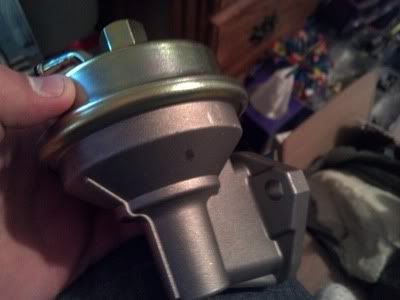 Under on the side of the fuel pump under the diaphram right? Yeah I bought a oil line kit that comes with the feed and return lines. Why would I need a second filter to the turbo if it's already filtered through the engine oil filter? I am pretty sure it is 6psi. Why is that too much? You said the stock rebuilt engine should be able to handle 10psi? I mean I checked all the cylinder's compressions and they're all good, it doesn't burn oil, what would be different between my engine and a rebuilt stock engine? I didn't buy an MSD box yet but it was on the agenda. Can I not just run it without much advance like 2 degrees advanced initial timing or none at all (set timing to TDC) so that it wouldn't predetonate until I get either an intercooler, MSD box, or meth/water injection? I just searched on ebay for the flanges I need. And yes they're the correct size and fit the studs [url=http://cgi.ebay.com/ebaymotors/?cmd=ViewItem&_trksid=p3984.m1439.l2649&item=150405543768&sspagename=STRK%3AMEWNX%3AIT#ht_3448wt_1165[/url] is the one that fits the manifold. The other one I got is for the exhaust of the turbo for the downpipe.
69 Buick Special Deluxe. Intercooled Turbo Chevy 250 @ 15psi on a stock long block. It's kinda fast.
|
|
|
|
|
Joined: Sep 2004
Posts: 5,839 Likes: 1
1000 Post Club
|
OP

1000 Post Club
Joined: Sep 2004
Posts: 5,839 Likes: 1 |
Correct area to drill. Use a drill stop as not to let the drill bit go too far in & hit the diaphram while you are drilling. You do not need a separate filter for the turbo,it was just a suggestion. I am saying,, for you to start off with really low boost,, if you start off w/6 psi & your timing is incorrect or your A/F ratio is way off (B.T.W.,, it will be off) or both are way off, you can destroy your cast piston engine very quickly. I am suggesting for you to start off w/1 psi, check for detonation ,observe your A/R ratios & proceed to make adjustments as needed. Then proceed to 2 psi, listen & check (take out spark plugs for visual insp.) Then adjust for 3 psi, listen for detonation, check your spark plugs, run 4 psi, listen for detonation check your plugs A/F ratios. Run 5 psi check for detonation, read your plugs. & so- on & so- on & so-on etc, etc, etc. http://www.nightrider.com/biketech/spkplghnbook.htm#Inhttp://www.theultralightplace.com/sparkplugs.htmhttp://www.google.com/imgres?imgurl=http...9QEwAQ&dur=3751You need to be on top of these things to check, if you don't take this boosted engine serious,,, say bye bye to your stock rebuilt eng. You can have your timing retarded, not run much total advance , your gas mileage will suffer greatly, throttle response will be sluggish. If you are not going to use an intercooler, no methanol injection, no MSD boost retard box, I would not run more than 4-6 psi range on pump 91 octane fuel w/conservative timing. This link you posted does not work. MBHD
12 port SDS EFI 
|
|
|
|
|
Joined: Sep 2004
Posts: 5,839 Likes: 1
1000 Post Club
|
OP

1000 Post Club
Joined: Sep 2004
Posts: 5,839 Likes: 1 |
Snowman,
on your fuel pump there should be a vent hole for the diaphram to work properly.
It's be a while since I used a mechanical FP I forgot where the vent hole is & if the area is large to drill a larger hole, tap it & install a fitting for your boost ref. line.
Look for the vent hole & post a pic when you get a chance.
Thanks
MBHD
12 port SDS EFI 
|
|
|
|
|
Joined: Mar 2010
Posts: 623
Major Contributor
|

Major Contributor
Joined: Mar 2010
Posts: 623 |
It does but it's up near the diaphragm and I wouldn't want to risk tearing or puncturing the diaphragm so I'm going to put it back down where I showed you earlier. Would I need to plug these holes so that the diaphragm will stay pressurized? 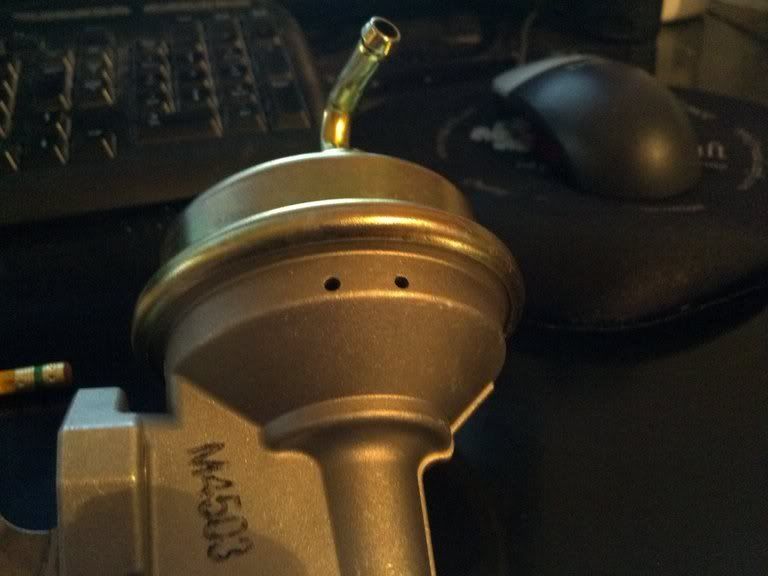
69 Buick Special Deluxe. Intercooled Turbo Chevy 250 @ 15psi on a stock long block. It's kinda fast.
|
|
|
|
|
Joined: Sep 2004
Posts: 5,839 Likes: 1
1000 Post Club
|
OP

1000 Post Club
Joined: Sep 2004
Posts: 5,839 Likes: 1 |
Snowman,
yes , you would need to plug up these holes if you are not going to use them for a boost ref. source.
MBHD
12 port SDS EFI 
|
|
|
|
|
Joined: Mar 2010
Posts: 623
Major Contributor
|

Major Contributor
Joined: Mar 2010
Posts: 623 |
what do you suggest I use to plug them? JB Weld? Try to weld them up???
Also does it matter what size the fitting is that goes from the fuel pump to the vacuum/boost nipple on the turbo? I was just planning on using an 1/8" brass pressure fitting like the size of the oil pressure sending unit's threads are.
69 Buick Special Deluxe. Intercooled Turbo Chevy 250 @ 15psi on a stock long block. It's kinda fast.
|
|
|
|
|
Joined: Sep 2004
Posts: 5,839 Likes: 1
1000 Post Club
|
OP

1000 Post Club
Joined: Sep 2004
Posts: 5,839 Likes: 1 |
A few choices. Tap the holes for a small screw. Install screws with wet sealant or JB weld. Install small pop rivits wet w/sealant or JB weld. Anyone else who can help, suggestions? You can run that pipe or a piece of silicone hose. http://cgi.ebay.com/ebaymotors/1-8-3mm-S...=item43aa216a78MBHD
12 port SDS EFI 
|
|
|
|
0 members (),
325
guests, and
48
robots. |
|
Key:
Admin,
Global Mod,
Mod
|
|
|
|

